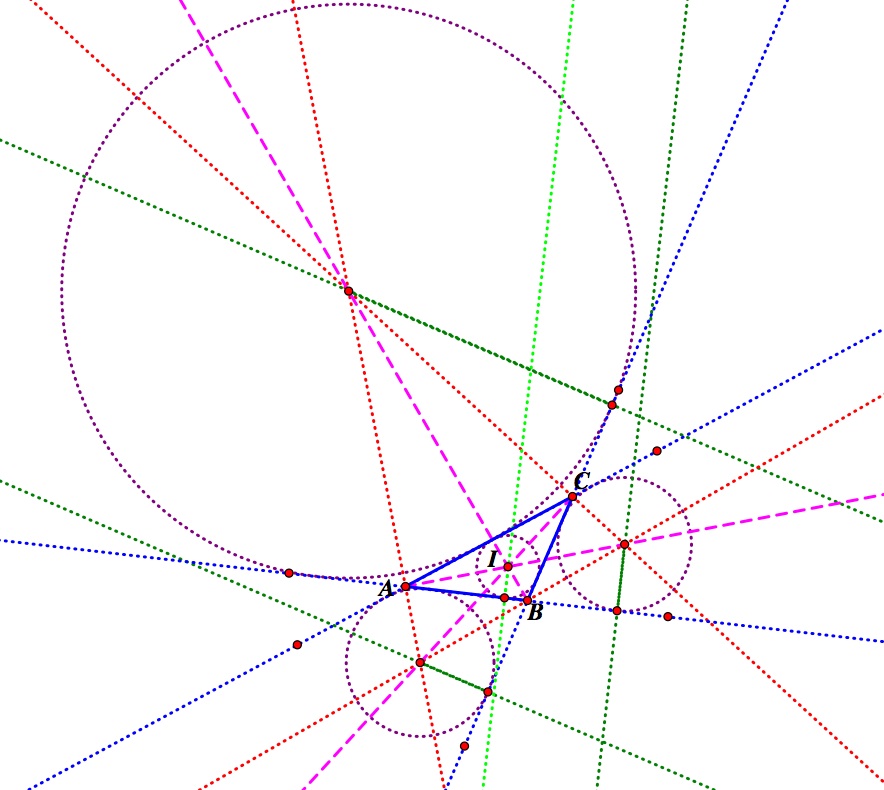

Allyson Faircloth
For this activity, we will be investigating the incircle and excircles of the triangle ABC.
In order to construct an incircle, we first need the incenter of the triangle. The incenter is the point which is equidistant from the three sides of the triangle. To find that point, we must construct angle bisectors for the three interior angles. The incenter is then where the angle bisectors are concurrent. We infact could have just found the intersection of two angle bisectors since that too will provide us with the incenter. Once you have the incenter you can construct your incircle since the radius will be the length from the incenter to any side since the incenter is equidistant from the sides of your triangle. Figure 1 below is the incircle constructed for triangle ABC. (Pink dashed lines are angle bisectos, green dotted line is the perpendicular line from the incenter to side AB, I is the incenter)Figure 1
In order to construct the excircles, we must first extend all the sides of the triangles. Next, we have to bisect the exterior angles that are between the two extended sides to which the triangle will be tangent. The intersection of the angle bisectors is the center of that excircle. We then must find the perpendicular line from that point to the side of the original triangle to which the excircle will be tangent. The segment of that perpendicular line from the intersection to the side of the triangle is the radius of the excenter. We can repeat this process to find the other two excenters. Figure 2 below on the left has all three excircles with all the construction stated above for triangle ABC. Figure 3 on the right shows the excircles for triangle ABC with some lines hidden so that the circles are easier to see as well as labeled points which will be used in later discussion.
Figure 2 Figure 3

From Figure 1, the points D, B, and E are collinear. We can prove this by first recognizing that angles ABG and CBH are vertical angles. D lies on the angle bisector of ABG and E lies on the angle bisector of EBH. Those two angle bisectors have a common point of B or furthermore the line which bisectors one angle is the same line which bisects that angle's vertical angle. Therefore D, B, and E are collinear since all three lie on the same line. We could similarly prove that points E, C, and F are collinear as well as points F, A, and D.
After seeing that these points are collinear, one may recognize that there is a triangle formed by the segments FD, DE, and EF. This triangle is formed by connecting the centers of the excircles. (See figure below.)
Is there something special about the relationship between that triangle and the incenter? Through investigation we may make the conjecture that the orthocenter of triangle FDE is the incenter of the original triangle ABC. (See figure below.) Let's try to prove our conjecture.
In order to construct triangle FDE, we bisected the exterior angles. Therfore, we can conclude that angle ACF is congruent to angle FCK. Also, we already proved that angle ACK and angle JCB are vertical angles, so angle JCB is bisected as well. That proves that angle BCE is congruent to angle ACF. The red dotted lines are the angle bisectors of triangle ABC. Therefore, angle ACI is congruent to angle BCI. Then, we know
angle ACI + angle ACF + angle BCI + angle BCE = 180 degrees
But,
angle ACI + angle ACF = angle BCI + angle BCE
So,
angle ACI + angle ACF + angle ACI + angle ACF = 180 degrees
2(angle ACI +angle ACF) = 180 degrees
angle ACI + angle ACF = 90 degrees
Therefore, the angle bisector of angle ACB is perpendicular to the line FCE, and since D is collinear with C we can conclude that the angle bisector of the original triangle is the altitude triangle FDE. Furthermore, the incenter of triangle ABC is the orthocenter of triangle FCE.
Return